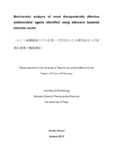Please use this identifier to cite or link to this item:
http://archive.nnl.gov.np:8080/handle/123456789/428Full metadata record
| DC Field | Value | Language |
|---|---|---|
| dc.contributor.author | Paudel, Atmika | |
| dc.date.accessioned | 2018-02-25T05:30:29Z | |
| dc.date.accessioned | 2020-08-21T08:05:51Z | - |
| dc.date.available | 2018-02-25T05:30:29Z | |
| dc.date.available | 2020-08-21T08:05:51Z | - |
| dc.date.issued | 2018-02-25 | |
| dc.identifier.uri | http://103.69.125.248:8080/xmlui/handle/123456789/428 | - |
| dc.description | Thesis submitted to The University of Tokyo for the partial fulfillment for the Degree of Doctor of Philosophy , Laboratory of Microbiology , Graduate School of Pharmaceutical Sciences, The University of Tokyo, 2013. | en_US |
| dc.description.abstract | Emergence of resistant bacterial strains shortly after the clinical use of antibiotics has made infections difficult to treat. In order to continuously overcome the infectious diseases, discovery of novel antimicrobial agents with novel mechanism of action is utmost important. Despite the need of the novel antimicrobial agents, less attention is paid by pharmaceutical industries on this field due to poor outcomes. Although many screening programs have attempted to identify antimicrobial agents, the discovery of therapeutically effective novel compounds is very difficult and has not been reported in recent years. This can be attributed to the conventional method of antibiotic discovery, in-vitro screening followed by in-vivo screening, where ethical issues make it difficult for the use of animal models at the early stage of drug development. In fact, the use of mammalian models to examine the pharmacodynamics requires larger and sophisticated space, skilled personnel; is costly and associated with ethical issues. To address these issues, I propose use of silkworm infection model for identification of novel therapeutically effective antimicrobial agents. Silkworm model not only reduces the time and cost of experiments, but also requires less space and there are no ethical issues surrounding its use. Here, I summarize the identification of two novel therapeutically effective antimicrobial agents: kaikosin E, and compound 363, which were obtained from culture broth of a lysobacter strain and a chemical library, respectively, by using silkworm bacterial infection model. Moreover, a detailed insight on the identification of mechanism of action of these antimicrobial agents is provided. Whenever a new compound is identified that is therapeutically effective and has a potential to be used for clinical purposes, the elucidation of mechanism becomes important. The elucidation of mechanism of action of such compounds not only helps in understanding the pharmacokinetics, pharmacodynamics and fate of drug molecule, but also helps in reducing treatment failure. | en_US |
| dc.language.iso | en | en_US |
| dc.subject | Antimicrobial agents | en_US |
| dc.subject | Silkworm bacterial infection model | en_US |
| dc.subject | Kaikosin E | en_US |
| dc.subject | Compound 363 | en_US |
| dc.title | Mechanistic analysis of novel therapeutically effective antimicrobial agents identified using silkworm bacterial infection model | en_US |
| dc.type | Thesis | en_US |
| Appears in Collections: | 600 Technology (Applied sciences) | |
Files in This Item:
| File | Description | Size | Format | |
|---|---|---|---|---|
| Thesis PhD Atmika revised version 3.pdf | 2.58 MB | Adobe PDF |  View/Open |
Items in DSpace are protected by copyright, with all rights reserved, unless otherwise indicated.